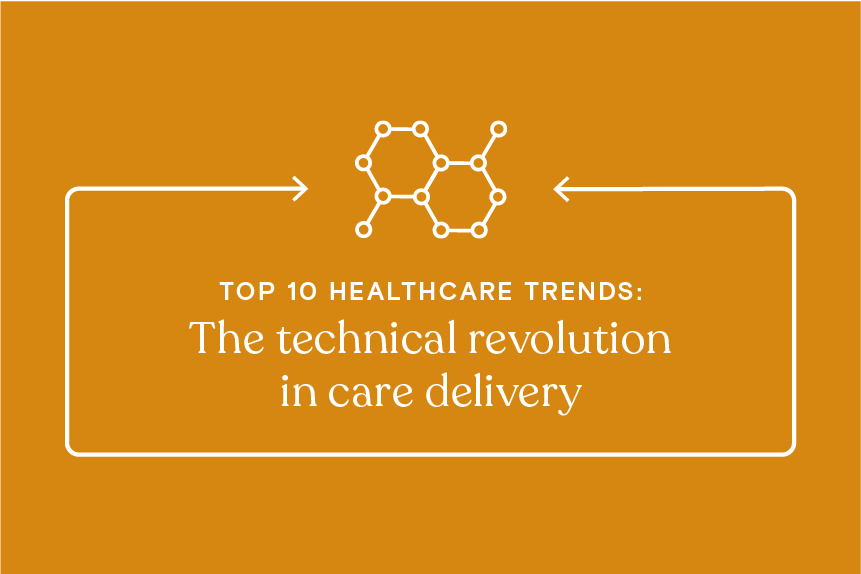Put your ear to the pulse of the healthcare landscape for a moment and it’s easy to hear how the latest technologies and other innovations are opening new frontiers in care delivery—or at least making us rethink long-held traditions.
The technical revolution in care delivery was one of the four core themes of Definitive Healthcare President Robert Musslewhite’s keynote at the end of Definitive LIVE! 2022, where he offered a data-driven look at the top 10 trends in healthcare today. If you missed Robert’s keynote, you can catch up on the first three parts of our recap series by reading:
- “The perfect storm,” which covers trends related to treatment delays, the staffing shortage and increasing costs.
- “The healthcare financial spreadsheet,” which explores the financial impact of COVID-19, and the pressure hospitals are feeling to consolidate.
- “The fundamentals of treatment are changing” which details the shift in care from inpatient to outpatient settings, the rapid growth of remote patient monitoring and the U.S. mental health epidemic.
For our final entry in this special blog series, we’ll expand upon the last two trends that Robert discussed:
- Telehealth is here to stay
- Precision medicine and genetic testing are accelerating personalized care
Telehealth is here to stay
Regular readers of our blog know we’ve covered the impact telehealth has had on the healthcare industry in detail. Even though the benefits of telehealth were championed by healthcare providers for years before the pandemic, it was COVID-19 that triggered explosive growth and adoption.
And the data proves that this technology isn’t just a fad.
Fig. 1. The number of telemedicine claims from 2019 to 2021 using ClaimsMx. Data accurate as of June 2022.
Our data show that there were about 1.2 million patients with a telemedicine claim in early 2019. In this pre-COVID era of telehealth, the technology was primarily used by healthcare providers to “combat the shortcomings of cost, quality and access [to] health care,” according to a report by the Brookings Institution.
By 2020, lockdown measures and social distancing guidelines kept millions of people indoors and concerned about seeing their physicians face-to-face. Healthcare providers needed to adapt to this new normal and began rolling out telehealth platforms in record numbers to meet patient needs online. As we can see from the chart, the number of telemedicine claims skyrocketed to more than 69 million in 2020 and increased slightly to more than 70 million in 2021.
So why is telehealth so widely used by patients and providers alike?
There are many reasons, which we explore in-depth in this webinar and in the second episode of our podcast, Virtual care is where you want to be, with Dan Trencher. However, to summarize, providers are using telehealth services to address problems caused by the ongoing staffing shortage, alleviate feelings of burnout, reduce avoidable readmissions and lower costs and more. For patients, telehealth is a convenient and accessible option that allows them to connect with their doctor from the comfort (and safety) of their homes.
Patients and providers realized telehealth is not a one-size-fits-all solution
As the pandemic continued, we expanded our look into telehealth usage to see which specialties were most (and least) suitable for the technology.
Mental health visits over telehealth, in particular, experienced incredible growth from 2020 to 2021. According to our data, less than 1% of all mental health visits were conducted virtually prior to the pandemic. By November 2021, however, the percentage of total visits using telehealth grew to nearly 39%.
Patients with mental health conditions likely gravitated to telehealth because the platform offers a safe, private environment for them to speak with their doctor. The negative stigma surrounding mental health is all too real, and in the future, we may see more conversations arise on how telehealth can help normalize mental health conditions.
Not all specialties saw the same amount of growth, which lead us to realize that telehealth is not a one-size-fits-all solution. As soon as lockdowns were lifted, we saw rapid shifts in patient visits back to the doctor’s office for specialties like audiology, dermatology and ophthalmology. By August 2021, dermatology visits over telemedicine plummeted to less than 1%, a figure that is still holding steady today.
This trend isn’t too surprising, however. These three specialties (and many others) typically need the physician to be in close contact with their patients to conduct an accurate, thorough examination. In addition, telehealth might not be the right tool for a physician to use if complex tools or machinery are required to make a diagnosis.
While telehealth might not be well-suited for every health condition, it’s not going away anytime soon. Today, many physicians incorporate a telemedicine platform as one component of their care delivery model, often complemented by traditional face-to-face visits when it is safe and appropriate to do so.
Precision medicine and genetic testing are accelerating personalized care
The last trend on Robert’s list is one of the hottest areas in all of healthcare right now—genetic testing and precision medicine.
Genetic testing is more accessible and affordable than ever before, thanks in part to advances in genomic sequencing made over the last two decades. The U.S. genetic testing market is also primed for opportunities. As we can see from the chart below, the market was valued at $4.4 billion in 2020. By 2027, the value is expected to more than double in size to about $10.3 billion.
Fig 2. Approximate valuation of the U.S. genetic testing market.
Genomic tests form the foundation for the rapidly emerging practice of precision medicine. In our webinar, “Big Data Around Diagnostics,” healthcare providers can use the information from a genetic test to help identify the root causes of a disease, which could lead to more precise treatments and better patient outcomes.
Precision medicine can be particularly effective in treating cancer. According to the CDC, more than 1.6 million people are diagnosed with cancer each year in the U.S., and nearly 600,000 die from it, making it the second leading cause of death. Precision medicine, which takes an individual’s genes, behavior and environment into account, could potentially lead to faster, more accurate cancer diagnoses and treatment plans.
Leveraging this data can be vital for life sciences companies bringing new therapies to market. Somatic genetic testing is one-way oncologists can study specific mutations in tumors, which could in turn help them better understand how cancers respond to certain treatment options. The benefits for patients, of course, can be game-changing. Not only could a personalized treatment plan help save a patient’s life, but it could also potentially reduce costs by eliminating unnecessary care and reducing lasting damage to the body from radiation.
And according to our data, hospitals are investing heavily in genetic testing tools and precision medicine. The number of hospitals that purchased molecular diagnostic software—a critical tool for using precision medicine to treat cancer—increased by nearly 10% between 2019 and 2021.
You can learn more about genetic testing and where it’s heading by listening to episode five of our podcast: Genetic testing is having a moment, with Kamal Gogineni and Dr. Rakesh Patel from Invitae.
So, what does this mean for you?
Robert offers two pieces of advice for any organization looking to take advantage of healthcare’s technical revolution:
- We’re still in the early stages of both virtual care and precision medicine. If you’re a technology provider, there’s a ton of opportunity for innovation in both markets, and healthcare systems are investing heavily to establish a foothold.
- If you’re a healthcare provider, practitioner, IDN or physician group, and you haven’t yet adopted these technologies, don’t worry, you’re not too late. But it’s probably time that you start educating yourself about telemedicine, genetic testing and precision medicine to figure out how your practice can or should take advantage of them.
Learn more
That’s it! A look at the final two trends impacting healthcare over the next year, based on market data and the Definitive Healthcare platform. You can catch up on all 10 healthcare trends by watching Robert’s full keynote or jump back to part one for a bit of a deeper dive.
Healthcare commercial intelligence can offer insight into these trends to help you navigate complexities in the healthcare industry and make more informed strategic decisions. You can also sign up for a free trial to get hands-on with our platform and see how we can help your business grow faster.





